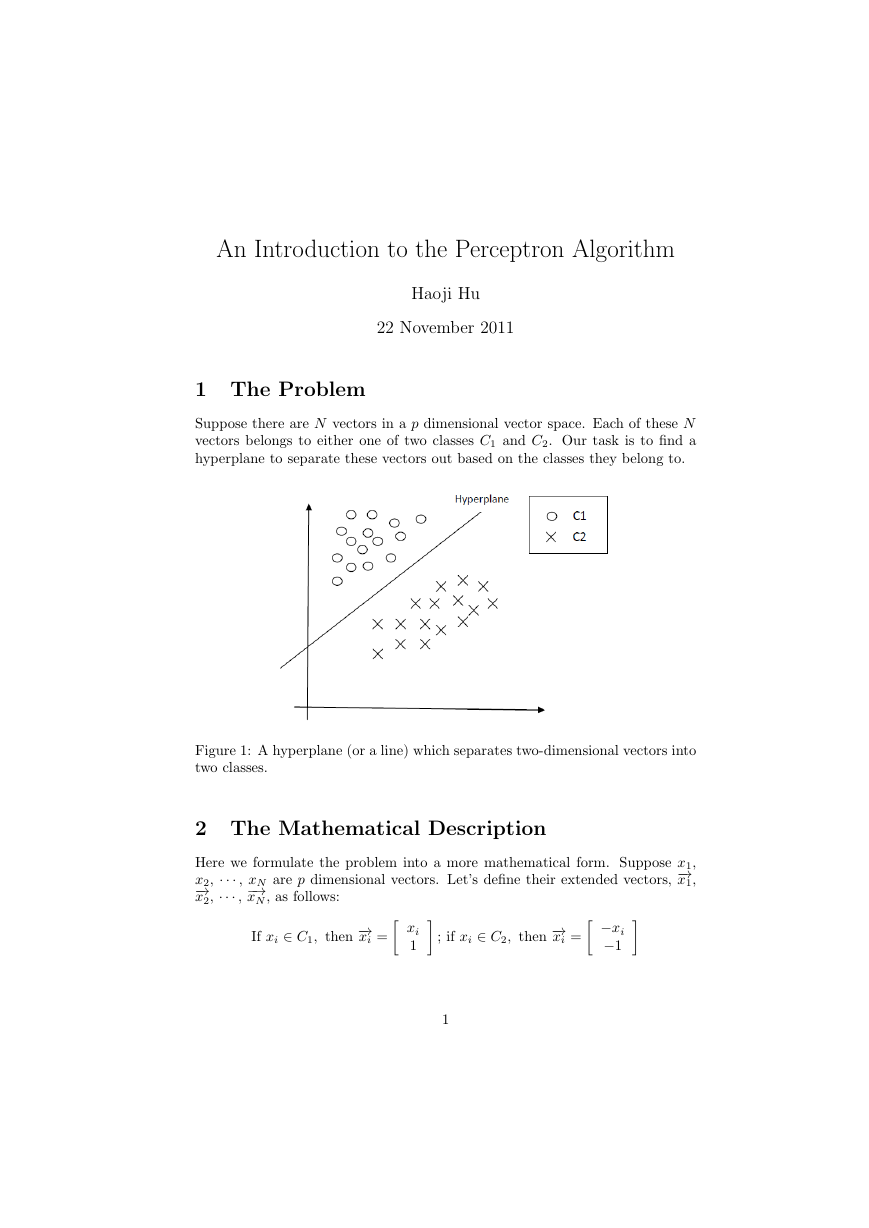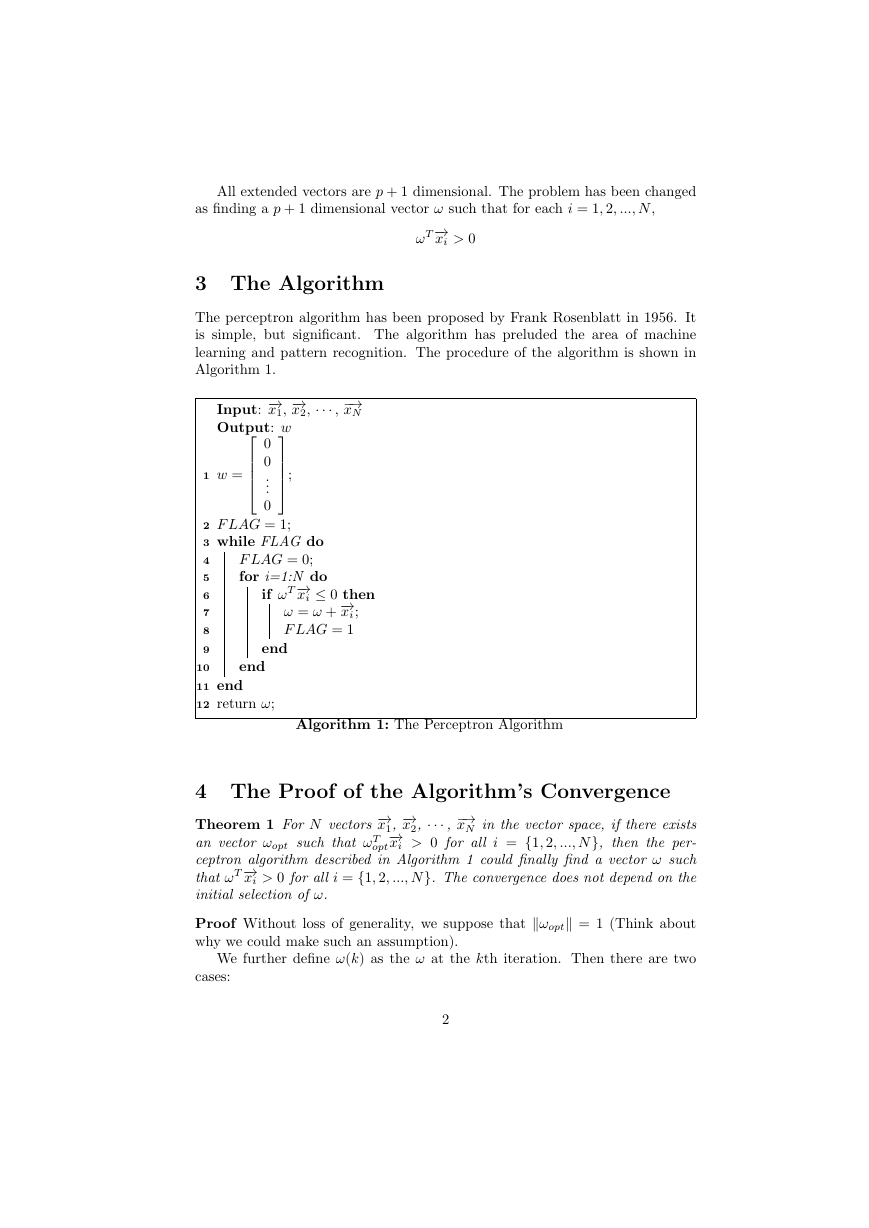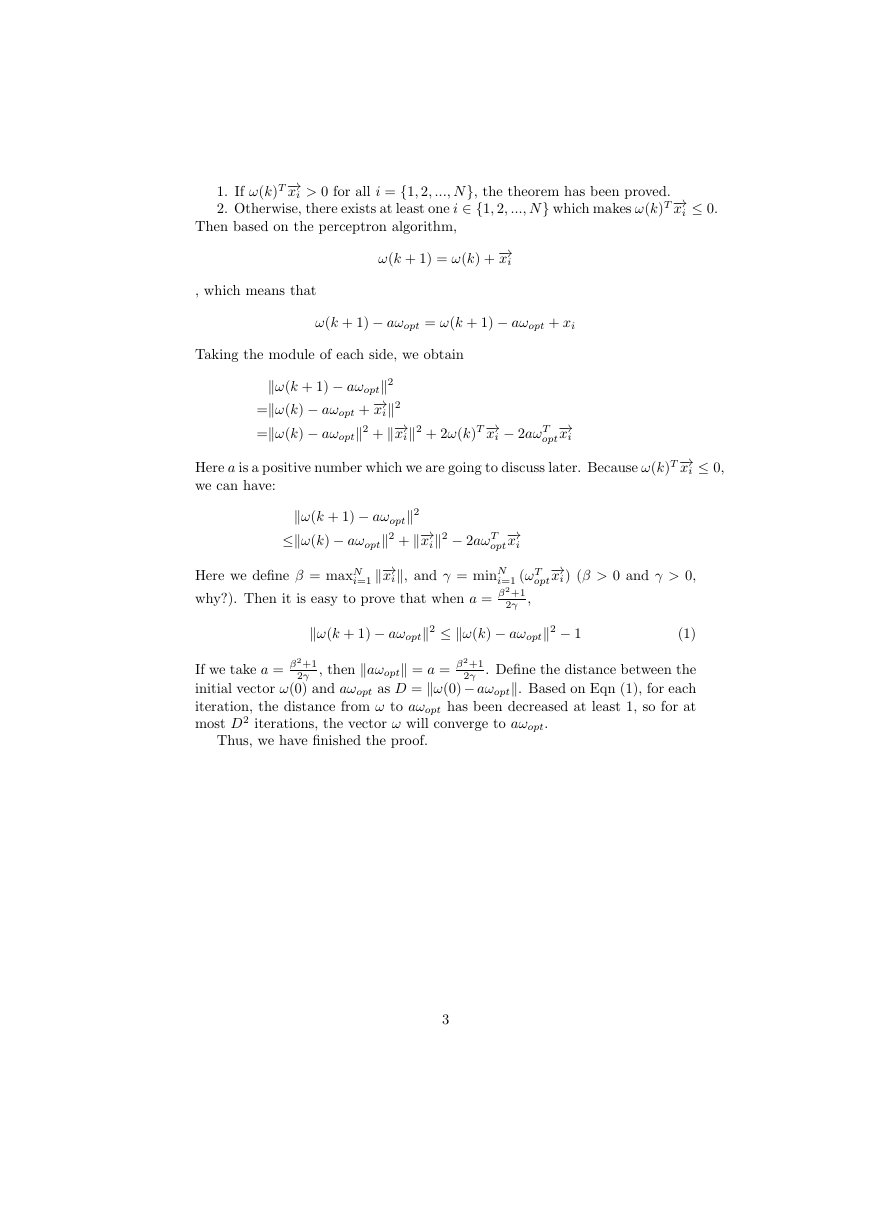An Introduction to the Perceptron Algorithm
Haoji Hu
22 November 2011
1 The Problem
Suppose there are N vectors in a p dimensional vector space. Each of these N
vectors belongs to either one of two classes C1 and C2. Our task is to nd a
hyperplane to separate these vectors out based on the classes they belong to.
Figure 1: A hyperplane (or a line) which separates two-dimensional vectors into
two classes.
2 The Mathematical Description
−→
Here we formulate the problem into a more mathematical form. Suppose x1,
x2, ··· , xN are p dimensional vectors. Let’s dene their extended vectors,
−→
x1,
x2, ··· ,
[
]
−→
xN , as follows:
If xi ∈ C1; then
−→
xi =
xi
1
]
[ −xi−1
; if xi ∈ C2; then
−→
xi =
1
�
All extended vectors are p + 1 dimensional. The problem has been changed
as nding a p + 1 dimensional vector ! such that for each i = 1; 2; :::; N ,
!T−→
xi > 0
3 The Algorithm
The perceptron algorithm has been proposed by Frank Rosenblatt in 1956. It
is simple, but signicant. The algorithm has preluded the area of machine
learning and pattern recognition. The procedure of the algorithm is shown in
Algorithm 1.
−→
x1,
Input:
Output: w
−→
x2, ··· ,
−→
xN
;
0
0
...
0
1 w =
2 F LAG = 1;
3 while FLAG do
4
F LAG = 0;
for i=1:N do
5
6
7
8
9
if !T−→
xi ≤ 0 then
−→
! = ! +
xi;
F LAG = 1
end
end
10
11 end
12 return !;
Algorithm 1: The Perceptron Algorithm
4 The Proof of the Algorithm’s Convergence
−→
−→
−→
x2, ··· ,
−→
x1,
xN in the vector space, if there exists
xi > 0 for all i = {1; 2; :::; N}, then the per-
xi > 0 for all i = {1; 2; :::; N}. The convergence does not depend on the
Theorem 1 For N vectors
an vector !opt such that !T
opt
that !T−→
ceptron algorithm described in Algorithm 1 could nally nd a vector ! such
initial selection of !.
Proof Without loss of generality, we suppose that ∥!opt∥ = 1 (Think about
why we could make such an assumption).
We further dene !(k) as the ! at the kth iteration. Then there are two
cases:
2
�
1. If !(k)T−→
xi > 0 for all i = {1; 2; :::; N}, the theorem has been proved.
2. Otherwise, there exists at least one i ∈ {1; 2; :::; N} which makes !(k)T−→
xi ≤ 0.
Then based on the perceptron algorithm,
!(k + 1) = !(k) +
−→
xi
, which means that
!(k + 1) − a!opt = !(k + 1) − a!opt + xi
Taking the module of each side, we obtain
∥!(k + 1) − a!opt∥2
−→
=∥!(k) − a!opt +
xi∥2
=∥!(k) − a!opt∥2 + ∥−→
xi∥2 + 2!(k)T−→
xi − 2a!T
−→
xi
opt
Here a is a positive number which we are going to discuss later. Because !(k)T−→
xi ≤ 0,
we can have:
∥!(k + 1) − a!opt∥2
≤∥!(k) − a!opt∥2 + ∥−→
xi∥2 − 2a!T
∥−→
xi∥, and = minN
opt
−→
xi
i=1 (!T
Here we dene = maxN
opt
why?). Then it is easy to prove that when a = 2+1
2 ,
i=1
−→
xi) ( > 0 and > 0,
∥!(k + 1) − a!opt∥2 ≤ ∥!(k) − a!opt∥2 − 1
2 , then ∥a!opt∥ = a = 2+1
If we take a = 2+1
2 . Dene the distance between the
initial vector !(0) and a!opt as D = ∥!(0)− a!opt∥. Based on Eqn (1), for each
iteration, the distance from ! to a!opt has been decreased at least 1, so for at
most D2 iterations, the vector ! will converge to a!opt.
(1)
Thus, we have nished the proof.
3
�






 2023年江西萍乡中考道德与法治真题及答案.doc
2023年江西萍乡中考道德与法治真题及答案.doc 2012年重庆南川中考生物真题及答案.doc
2012年重庆南川中考生物真题及答案.doc 2013年江西师范大学地理学综合及文艺理论基础考研真题.doc
2013年江西师范大学地理学综合及文艺理论基础考研真题.doc 2020年四川甘孜小升初语文真题及答案I卷.doc
2020年四川甘孜小升初语文真题及答案I卷.doc 2020年注册岩土工程师专业基础考试真题及答案.doc
2020年注册岩土工程师专业基础考试真题及答案.doc 2023-2024学年福建省厦门市九年级上学期数学月考试题及答案.doc
2023-2024学年福建省厦门市九年级上学期数学月考试题及答案.doc 2021-2022学年辽宁省沈阳市大东区九年级上学期语文期末试题及答案.doc
2021-2022学年辽宁省沈阳市大东区九年级上学期语文期末试题及答案.doc 2022-2023学年北京东城区初三第一学期物理期末试卷及答案.doc
2022-2023学年北京东城区初三第一学期物理期末试卷及答案.doc 2018上半年江西教师资格初中地理学科知识与教学能力真题及答案.doc
2018上半年江西教师资格初中地理学科知识与教学能力真题及答案.doc 2012年河北国家公务员申论考试真题及答案-省级.doc
2012年河北国家公务员申论考试真题及答案-省级.doc 2020-2021学年江苏省扬州市江都区邵樊片九年级上学期数学第一次质量检测试题及答案.doc
2020-2021学年江苏省扬州市江都区邵樊片九年级上学期数学第一次质量检测试题及答案.doc 2022下半年黑龙江教师资格证中学综合素质真题及答案.doc
2022下半年黑龙江教师资格证中学综合素质真题及答案.doc